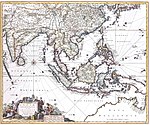Dutch Ethical Policy
| History of Indonesia |
|---|
 |
| Timeline |
|
|
The Dutch Ethical Policy (Ethische Politiek) was the official policy of the colonial government of the Dutch East Indies (present-day Indonesia) during the four decades from 1901 until the Japanese occupation of 1942. In 1901, the Dutch Queen Wilhelmina announced that the Netherlands accepted an ethical responsibility for the welfare of their colonial subjects. This announcement was a sharp contrast with the former official doctrine that Indonesia was a wingewest (region for making profit). It also marked the start of modern development policy; whereas other colonial powers talked of a civilising mission, which mainly involved spreading their culture to colonised peoples.
The Policy emphasised improvement in material living conditions. It suffered, however, from severe underfunding, inflated expectations and lack of acceptance in the Dutch colonial establishment, and it had mostly ceased to exist by the onset of the Great Depression in 1930.[1][2]
Formulation[]

In 1899, the liberal Dutch lawyer Conrad Theodor van Deventer published an essay in the Dutch journal De Gids which claimed that the Colonial Government had a moral responsibility to return the wealth that the Dutch had received from the East Indies to the indigenous population.
Journalist (1845-1921),[3] wrote about the moral duty of the Dutch to provide more for the peoples of the Indies. With the support of socialists and concerned middle-class Dutch, he campaigned against what he saw as the unjustness of the colonial surplus. He described the Indies indigenous peoples as "childlike" and in need of assistance, not oppression. Newspapers were one of the few mediums of Indies communication to the Dutch parliament, and as editor of the De Locomotief, the largest of the Dutch-language newspapers in the Indies, he published writing by Snouck Hurgronje on understanding Indonesians. Brooshooft sent reporters across the archipelago to report on local developments; they reported on the poverty, crop failure, famine and epidemics in 1900. Lawyers and politicians supportive of Brooshooft's campaigning had an audience with Queen Wilhelmina and argued that the Netherlands owed the peoples of the Indies a 'debt of honour'.[3]
In 1901, the Queen, under advice from her prime minister of the Christian Anti-Revolutionary Party, formally declared a benevolent "Ethical Policy" which was aimed at bringing progress and prosperity to the peoples of the Indies. The Dutch conquest of the Indies brought them together as a single colonial entity by the early 20th century, which was fundamental to the Policy's implementation.[4]
Proponents of the Policy argued that financial transfers should not be made to the Netherlands while conditions for the indigenous peoples of the archipelago were poor.
Aims[]
Supporters of the Policy were concerned about the social and cultural conditions holding back the native population. They tried to raise awareness among the natives of the need to free themselves from the fetters of the feudal system and to develop themselves along Western lines.
On 17 September 1901, in her speech from the throne before the States-General, the newly crowned Queen Wilhelmina formally articulated the new policy - that the Dutch government had a moral obligation to the native people of the Dutch East Indies that could be summarised in the 'Three Policies' of Irrigation, Transmigration and Education.
Irrigation[]

The Policy promoted efforts to improve the lot of the ordinary people through irrigation programmes, the introduction of banking services for the native population, and subsidies for native industries and handicrafts.
Migration[]
The Policy first introduced the concept of transmigration from over-populated Java to the less densely populated areas of Sumatra and Kalimantan, beginning with government-sponsored schemes from 1905 onwards. However, the numbers of people moved during the period of the Policy was a tiny fraction of the increase in population in Java during the same period.
Education[]

The opening of Western education to indigenous Indonesians began only at the beginning of the 20th century; in 1900. Only 1,500 went to European schools compared to 13,000 Europeans. By 1928, however, 75,000 Indonesians had completed Western primary education and nearly 6,500 secondary school, although this was still a tiny proportion of the population.[5]
Assessment[]
The Policy was the first serious effort to create programmes for economic development in the tropics. It differed from the "civilising mission" of other colonial powers in emphasising material welfare rather than a transfer of culture. The educational component of the Policy was mainly technical as it did not aim at creating brown Dutchmen and women. The Policy foundered on two problems. First, the budgets allocated to the Policy's programmes were never sufficient to achieve its aims, with the result that many colonial officials became disillusioned with the possibility of achieving lasting progress. The financial stringencies of the Great Depression put a definitive end to the Policy. Second, the educational programmes of the Policy contributed significantly to the Indonesian National Revival, giving Indonesians the intellectual tools to organise and to articulate their objections to colonial rule. As a result, many in the colonial establishment saw the Policy as a mistake that was counter to Dutch interests.[1]
Notable ethical politicians[]
See also[]
- Cultivation System
- Dutch East Indies
- Dutch Empire
- History of Indonesia
- Indonesian National Revolution
References[]
Notes[]
- ^ a b Cribb, Robert (1993). "Development Policy in the Early 20th Century", in Jan-Paul Dirkse, Frans Hüsken and Mario Rutten, eds, Development and Social Welfare: Indonesia’s Experiences under the New Order (Leiden: Koninklijk Instituut voor Taal-, Land- en Volkenkunde), pp. 225-245.
- ^ Ricklefs, M.C. (1991). A History of Modern Indonesia Since c.1300. London: Macmillan. p. 151. ISBN 0-333-57690-X.
- ^ a b Vickers, Adrian (2005). A History of Modern Indonesia. Cambridge University Press. p. 17. ISBN 0-521-54262-6.
- ^ Vickers, Adrian (2005). A History of Modern Indonesia. Cambridge University Press. p. 18. ISBN 0-521-54262-6.
- ^ Vickers, Adrian (2005). A History of Modern Indonesia. Cambridge University Press. p. 40. ISBN 0-521-54262-6.
General references[]
External links[]
- Dutch East Indies
- Economic history of Indonesia